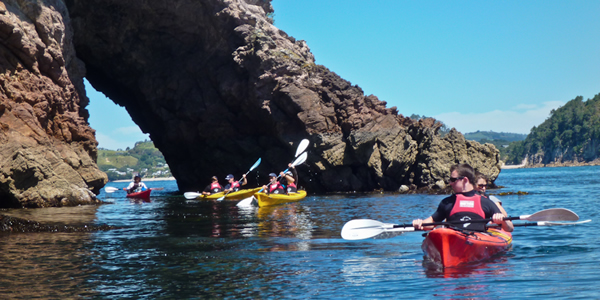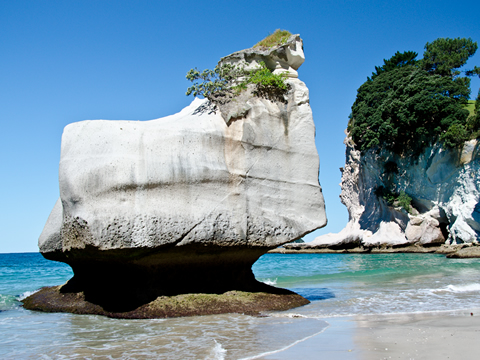Kayaking Cathedral Cove

Sea kayaking to Cathedral Cove on the Coromandel Peninsula, North Island, New Zealand.
A kayak trip through the marine reserve near Hahei to Cathedral Cove, famous from films and 1,001 New Zealand postcards
Cathedral Cove kayakTour length: 3.5 hrs
Tour times: 8:45am, 1:45pm.
Tour cost: NZ$95 (US$75)

Cathedral Cove Sea Kayaking
Tel. +64-(0)7-866-3877 or toll free in NZ 0800-529-258
www.seakayaktours.co.nz
Tip: Book at least 24 hours in advance.
Tip: Wear comfy, loose, warm clothes (no jeans) and sandals or flip-flops. They privide PFDs and windbreakers, but you kayak in your clothes, so wear stuff that can get wet—especially shoes.
We rounded an offshore islet on Pacific swells, threaded our kayaks through narrow a sea cave that had wormed its way through the rock, and suddenly there it was: Cathedral Cove, jewel of New Zealand’s Coromandel Peninsula.
Twin sugar-sand beaches curved under cliffs to either side of a narrow promontory.
Bone-white shards of limestone 30 feet high littered the waterline where they had fallen from the cliff side long ago to be sculpted by the surf.
Our little group of kayakers paddled to shore and nosed our narrow craft onto the beach.
While our guide spread out a blanket and set about brewing tea and cappuccino and opening Tupperware bins of sweet biscuits, we tugged off our neoprene spray skirts and padded across the soft sands to explore.
We wandered under the cavernous vaults of the cove’s namesake tunnel-like arch worn straight through the headland.

One of the distinctive boulders at Cathedral Cove on the Coromandel Peninsula.On the far side: Mare’s Leg Cove, an equally idyllic beach punctuated by more of those wave-carved tumbledown limestone boulders and shaded by pohutukawa trees, which explode with bright red blooms in late December earning them the nickname the New Zealand Christmas Tree.
On the way back to the beach at Hahei, our kayaks hugged the shore, dipping into several other small coves.
Giant rays glided under our boats in sandy Stingray Bay.
Buoys scattered around Gemstone Bay marked a "snorkeling trail" with plaques identifying the snapper, rays, crayfish, and other underwater life teeming through the protected waters beneath our boats.
Best... endorsement... everKayaking Cathedral Cove just may be best thing to do in New Zealand, but don't take my word for it.
I learned long ago that the only way to avoid spending an excruciating cocktail party evening clutching your wine glass miserably in a corner, wishing there was someone you already knew to talk to, is simply to turn to the random person standing next to you, stick out your hand, and introduce yourself.
“Hi, my name is Reid.”
“Hello,” replied the woman the brown pants suit standing next to me. “I’m Helen,” she said, shaking my hand.
From her accent, I knew she was Kiwi. Not that I am that good with accents, but because this particular cocktail party was a press event organized by Peter Greenberg as a way to kill time before the New York premier of Lord of the Rings: The Two Towers.
The magazine I was working for in 2002 had managed to finagle a few tickets this red carpet event. (Tourism New Zealand viewed the Lord of the Rings movies essentially as free, three-hour commercials for New Zealand’s natural beauty and took full advantage, using it to help woo travel journalists.)
As just such a journalist, I often ask people about their favorite thing to do in their hometown, region, state, or country.
So I asked Helen.
As most people do, she hemmed and hawed for a few moments about how everything is lovely and it would be impossible to pick—but then she pinpointed one thing.
“I recently kayaked Cathedral Cove. It was quite spectacular.”
Just then, a man materialized out of the swirling crowd and leaned in to speak to Helen.
“Excuse me, Madame Prime Minister, but there’s someone over here you should meet.”
I mention all of this not to congratulate myself for unwittingly chitchatting with a head of state (now former head of state; the Right Honorable Helen Clark currently serves as the U.N.'s third-ranking member, the Adminstrator of the Development Programme), but to point out two things:
1) Kayaking Cathedral Cove has received one of the best endorsements any New Zealand activity could possibly hope for.
2) You’ll never know who’s standing next to you a cocktail party until you stick out your hand and introduce yourself.
How to get to Cathedral Cove
By foot
Note that recent rock falls within the “cathedral” cave have led authorities to rope it off, so the only way to access the Cathedral Cove beach is by water.
There is a land trail from a parking lot off Grange Road at the north end of Hahei town that winds through the bush, passing Gemstone Bay and Stingray Bay and ending at Mare’s Leg Cove (the beach on the south side of that archway cavern).
The walk takes 30–45 minutes.
By kayak
Cathedral Cove Sea Kayaking (tel. +64-(0)7-866-3877 or toll free in NZ 0800-529-258, www.seakayaktours.co.nz) charges NZ$95/US$75 to kayak the waters of the nine square-kilometer Te Whanganui-A-Hei marine reserve from Hahei beach up to Cathedral Cove. Book ahead.
Trips takes about 3.5 hours total.
By glass-bottomed boat
Too tired to paddle? Take a two-hour glass bottom boat tour from Whitianga for NZ$90 with Mercury Bay Seafaris (tel. +64-(0)7-867-1962 or 021-478-290, www.glassbottomboatwhitianga.co.nz).
Tours cost NZ$90 and leave at 8am, 10:30am, 1:30pm, and 4pm (just the two middle departures in winter). Booking is essential.
The rubber boat
A final option is to ride here on a rigid-hull inflatable boat (picture an oversized Zodiac raft with a hard floor and a big outboard motor) with the glass bottom boat's sister company, Hahei Explorer (tel. +64-(0)7-866-3910, www.haheiexplorer.co.nz).
The tour of the marine reserve and Cathedral Cove lasts an hour and costs NZ$70.
Tours depart at 9am, 10am, 2pm, and 3pm daily or on demand (again, just the two middle departures in winter).
Book ahead—preferably 24 hours.
Related Articles |
Related Partners
|
This article was by Reid Bramblett and last updated in October 2011.
All information was accurate at the time.
Copyright © 1998–2013 by Reid Bramblett. Author: Reid Bramblett.
